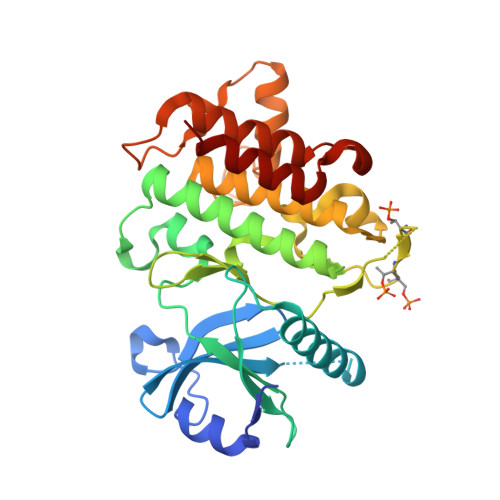Overcoming adaptive therapy resistance in AML by targeting immune response pathways.
Melgar, K., Walker, M.M., Jones, L.M., Bolanos, L.C., Hueneman, K., Wunderlich, M., Jiang, J.K., Wilson, K.M., Zhang, X., Sutter, P., Wang, A., Xu, X., Choi, K., Tawa, G., Lorimer, D., Abendroth, J., O'Brien, E., Hoyt, S.B., Berman, E., Famulare, C.A., Mulloy, J.C., Levine, R.L., Perentesis, J.P., Thomas, C.J., Starczynowski, D.T.(2019) Sci Transl Med 11
- PubMed: 31484791
- DOI: https://doi.org/10.1126/scitranslmed.aaw8828
- Primary Citation of Related Structures:
6MOM - PubMed Abstract:
Targeted inhibitors to oncogenic kinases demonstrate encouraging clinical responses early in the treatment course; however, most patients will relapse because of target-dependent mechanisms that mitigate enzyme-inhibitor binding or through target-independent mechanisms, such as alternate activation of survival and proliferation pathways, known as adaptive resistance. Here, we describe mechanisms of adaptive resistance in FMS-like receptor tyrosine kinase (FLT3)-mutant acute myeloid leukemia (AML) by examining integrative in-cell kinase and gene regulatory network responses after oncogenic signaling blockade by FLT3 inhibitors (FLT3i). We identified activation of innate immune stress response pathways after treatment of FLT3-mutant AML cells with FLT3i and showed that innate immune pathway activation via the interleukin-1 receptor-associated kinase 1 and 4 (IRAK1/4) complex contributes to adaptive resistance in FLT3-mutant AML cells. To overcome this adaptive resistance mechanism, we developed a small molecule that simultaneously inhibits FLT3 and IRAK1/4 kinases. The multikinase FLT3-IRAK1/4 inhibitor eliminated adaptively resistant FLT3-mutant AML cells in vitro and in vivo and displayed superior efficacy as compared to current targeted FLT3 therapies. These findings uncover a polypharmacologic strategy for overcoming adaptive resistance to therapy in AML by targeting immune stress response pathways.
Organizational Affiliation:
Division of Experimental Hematology and Cancer Biology, Cincinnati Children's Hospital Medical Center, Cincinnati, OH 45229, USA.


















